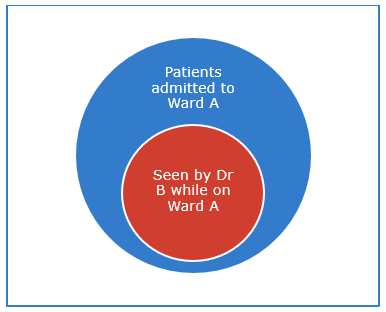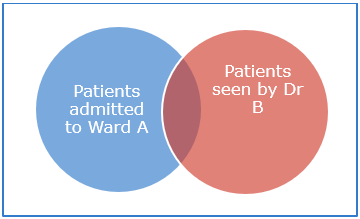User-created cohorts interact with base cohorts
There is an important difference in the way cohorts function when used as a base cohort and when used in Cohort discovery. Suppose we have two base cohorts: one comprising All patients and the other Patients admitted to Ward A. It may appear as if the following two combinations are (or should be) equivalent:
Base cohort=All patients & Scope=admitted to Ward A.
Base cohort=Patients admitted to Ward A & Scope=All.
However, this is not necessarily the case. The reason for this can be seen by adding in an additional scope selection: Doctor B to both examples.
In the first case, this will identify all patients who were seen by Dr. B while on Ward A. This is a strict subset of those patients seen on Ward A (first diagram below):

The second case will identify all patients admitted to Ward A AND seen by Dr. B, i.e. the intersection between the two cohorts. The difference is that some of these patients may not have been seen by Dr. B on Ward A (second diagram below). They could, for example, have been seen by Dr. B on Ward C but still meet the selection criteria:

The rationale for this difference can be clarified by the following example.
As a practitioner on Ward A you would expect to have access to a patient’s full case notes (at least for the service they are involved with) rather than just the notes for admissions to the ward the patient happens to be on at that moment.
If the latter was all you were handed you could not begin to undertake any meaningful analysis of that patient’s health history. Similarly, with a base cohort the data available to a base cohort is ALL data for that cohort, not just data for the period in which the patients met the cohort definition.
For example, if the base cohort were patients with a diagnosis of lung cancer you would want access to data prior to those patients receiving such a diagnosis. Were such data to be restricted to data collected while they had lung cancer, many meaningful analyses would be impossible.
On the other hand, were you to be auditing treatment of lung cancer patients on your ward, you would only wish to identify patients who saw Dr. B whilst on your ward – you would not wish to be inadvertently including data from when they saw Dr. B five years ago on a different ward and prior to the diagnosis of lung cancer.